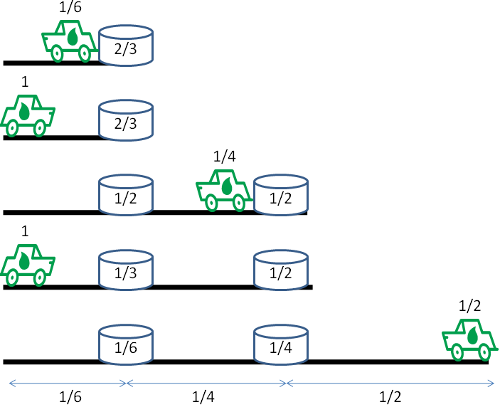
An adventurer wants to explore a desert. He has a jeep that can carry up to 1 unit of fuel at any time and that will travel 1 unit of distance on 1 unit of fuel. As he travels he can leave any amount of the fuel that he’s carrying at any point, as a fuel dump to be picked up later. He starts from a fixed base at the edge of the desert, where there’s an unlimited supply of fuel. How far into the desert can he go if he wants to return safely to the base at the end of each trip?
Surprisingly, with some intelligent planning he can go as far as he likes. The diagram above shows how far he can get with 3 trips:
- On the first trip he departs the base with 1 unit of fuel. He drives 1/6 unit into the desert, leaves 2/3 units of fuel at a fuel dump, and returns to the base using the remaining 1/6 unit of fuel.
- On the second trip he leaves the base with 1 unit of fuel, drives 1/6 unit to the fuel dump, and draws 1/6 unit from the dump. Now he’s carrying 1 unit of fuel. Then he drives 1/4 unit farther into the desert and leaves 1/2 unit at a new dump. Now he has 1/4 unit of fuel remaining, which is just enough to reach the first fuel dump, where he collects another 1/6 unit of fuel and returns to base.
- On the third trip he drives 1/6 unit to reach the first fuel dump, where he tops up with 1/6 unit of fuel (leaving 1/6 unit remaining there). Then he drives 1/4 to the second dump, where he collects 1/4 unit of fuel (again topping up to 1 full unit). (1/4 unit now remains in the second fuel dump.) Now he can drive 1/2 unit distance into the desert before he has to return to the second fuel dump, where he collects the remaining 1/4 unit fuel, which enables him to reach the first fuel dump, where he collects the last 1/6 unit of fuel, which is just enough to get back to base.
So if 3 trips are planned the explorer can travel a round-trip distance of 1 + 1/2 + 1/3 = 11/6 units. You can see the pattern: If the explorer had planned 4 trips, he would set up fuel dumps at distances of 1/8, 1/6, and 1/4 from the base, initially storing 3/4, 2/3, and 1/2 units at each and then drawing 1/8, 1/6, and 1/4 units of fuel from each on each visit. As before, on the final trip he could depart the last fuel dump with a full tank, drive 1/2 unit into the desert, and then return to the base, exhausting each fuel dump on the way. In that case he’d have traveled a round-trip distance of 1 + 1/2 + 1/3 + 1/4 = 25/12 units.
This is just the harmonic series, 1 + 1/2 + 1/3 + 1/4 + 1/5 + …, which is divergent — in principle, at least, the explorer can travel as far as he likes into the desert, provided he plans a large enough series of trips. In practice it would be very difficult, though — both the number of fuel dumps and the total amount of fuel necessary increase exponentially with the distance to be traveled.
